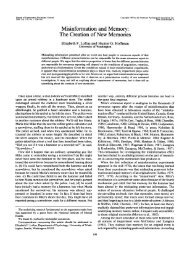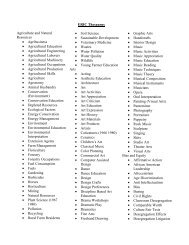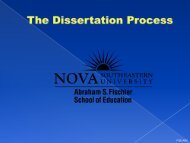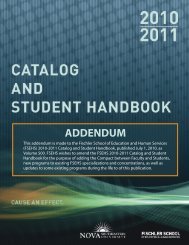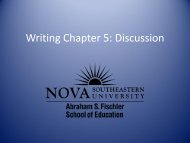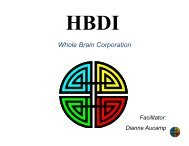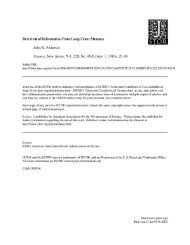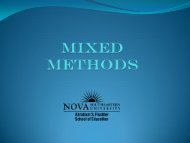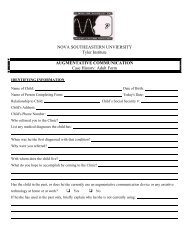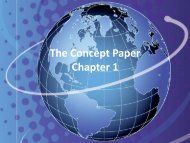Class Size and Interaction in Online Courses - 1 - Nova ...
Class Size and Interaction in Online Courses - 1 - Nova ...
Class Size and Interaction in Online Courses - 1 - Nova ...
You also want an ePaper? Increase the reach of your titles
YUMPU automatically turns print PDFs into web optimized ePapers that Google loves.
<strong>Class</strong> <strong>Size</strong> <strong>and</strong> <strong>Interaction</strong><br />
<strong>in</strong> Onl<strong>in</strong>e <strong>Courses</strong><br />
Anymir Orellana, EdD<br />
<strong>Nova</strong> Southeastern University<br />
orellana@nova.edu<br />
NSU’s Best Practices <strong>in</strong> Onl<strong>in</strong>e Learn<strong>in</strong>g Forum<br />
October 2006<br />
<br />
<br />
<br />
<br />
<br />
<br />
<br />
<br />
<br />
<br />
<br />
<strong>Class</strong> <strong>Size</strong> <strong>and</strong> <strong>Interaction</strong> <strong>in</strong> Onl<strong>in</strong>e<br />
<strong>Courses</strong><br />
Why <strong>Class</strong> <strong>Size</strong> <strong>and</strong> <strong>Interaction</strong>?<br />
Ma<strong>in</strong> Research Questions<br />
Def<strong>in</strong>itions: onl<strong>in</strong>e course, <strong>in</strong>teraction, <strong>in</strong>teractive qualities<br />
Methodology<br />
Web-based based Questionnaire (CSIQ)<br />
Demographics of Instructors<br />
General Characteristics of Onl<strong>in</strong>e <strong>Courses</strong><br />
Perceptions of Optimal <strong>Class</strong> <strong>Size</strong>s<br />
Average <strong>Class</strong> <strong>Size</strong>s of Onl<strong>in</strong>e <strong>Courses</strong><br />
Summary of Results<br />
Highly <strong>in</strong>teractive courses<br />
A. Orellana, EdD. October 2006<br />
2<br />
1
Why <strong>Class</strong> <strong>Size</strong> <strong>and</strong> <strong>Interaction</strong>?<br />
<strong>Class</strong> size has been a concern <strong>in</strong> traditional education<br />
for more than a century.<br />
There is a lack of reported research address<strong>in</strong>g class<br />
size <strong>in</strong> onl<strong>in</strong>e education<br />
Research suggests that <strong>in</strong>teraction is important to the<br />
development <strong>and</strong> delivery of distance education<br />
The relationship between <strong>in</strong>teraction <strong>and</strong> class size is<br />
highlighted <strong>in</strong> policies, accreditation st<strong>and</strong>ards, <strong>and</strong><br />
best-practice guidel<strong>in</strong>es for onl<strong>in</strong>e courses<br />
A. Orellana, EdD. October 2006<br />
3<br />
Ma<strong>in</strong> Research Questions<br />
<br />
<br />
<br />
What are <strong>in</strong>structors’ perceptions of optimal<br />
class sizes for onl<strong>in</strong>e courses with different<br />
levels of <strong>in</strong>teractive qualities?<br />
What are typical class sizes of onl<strong>in</strong>e courses?<br />
What are typical levels of <strong>in</strong>teractive qualities<br />
of onl<strong>in</strong>e courses?<br />
A. Orellana, EdD. October 2006<br />
4<br />
2
Onl<strong>in</strong>e <strong>Courses</strong><br />
counted for credit towards a degree <strong>in</strong> a<br />
bachelor’s, master’s, or doctoral program from<br />
some American higher education <strong>in</strong>stitution;<br />
taught at a distance at least 80% of the time<br />
us<strong>in</strong>g <strong>in</strong>teractive telecommunications systems,<br />
perhaps with occasional traditional face-to-face<br />
activities;<br />
taught by a s<strong>in</strong>gle <strong>in</strong>structor sometime <strong>in</strong> the<br />
past 5 years with no teach<strong>in</strong>g assistant, or the<br />
like.<br />
A. Orellana, EdD. October 2006<br />
5<br />
<strong>Interaction</strong><br />
“Communication or dialog that occurs between<br />
<strong>in</strong>structors <strong>and</strong> learners or among learners. May be<br />
time-delayed (asynchronous) or real-time<br />
(synchronous)” (Schlosser & Simonson, 2002, p. 111).<br />
Achieved “through a complex <strong>in</strong>terplay of social,<br />
<strong>in</strong>structional, <strong>and</strong> technological variables” (Roblyer &<br />
Wiencke, 2003, p. 1).<br />
Describes “a created environment <strong>in</strong> which both social<br />
<strong>and</strong> <strong>in</strong>structional messages are exchanged among the<br />
entities <strong>in</strong> the course <strong>and</strong> <strong>in</strong> which messages are both<br />
carried <strong>and</strong> <strong>in</strong>fluenced by the activities <strong>and</strong> technology<br />
resources be<strong>in</strong>g employed” (Roblyer & Wiencke, p. 81).<br />
A. Orellana, EdD. October 2006<br />
6<br />
3
Interactive Qualities<br />
Features of <strong>in</strong>teraction <strong>and</strong> <strong>in</strong>teractivity of a<br />
distance course<br />
Level determ<strong>in</strong>ed by five measurable <strong>and</strong><br />
observable <strong>in</strong>dicators (Roblyer & Wiencke,<br />
2003):<br />
Social/rapport-build<strong>in</strong>g designs for <strong>in</strong>teraction,<br />
<strong>in</strong>structional designs for <strong>in</strong>teraction,<br />
<strong>in</strong>teractivity of technology resources,<br />
evidence of learner engagement, <strong>and</strong><br />
evidence of <strong>in</strong>structor engagement<br />
A. Orellana, EdD. October 2006<br />
7<br />
Methodology<br />
Web-based based questionnaire<br />
e-mails collected from conferences, journals, <strong>and</strong><br />
<strong>in</strong>stitutions’ Web sites<br />
Participants were <strong>in</strong>structors that sometime <strong>in</strong><br />
the past 5 years had taught an onl<strong>in</strong>e course as<br />
def<strong>in</strong>ed <strong>in</strong> the study<br />
211 replies (154 qualified <strong>and</strong> 57 self-reported as<br />
unqualified), a 33.8% response rate<br />
131 usable cases were analyzed<br />
Instructors self-assessed their most recently<br />
taught onl<strong>in</strong>e course<br />
A. Orellana, EdD. October 2006<br />
8<br />
4
Web-based based Questionnaire (CSIQ)<br />
Demographics of <strong>in</strong>structors<br />
General characteristics of onl<strong>in</strong>e courses<br />
Rubric for Assess<strong>in</strong>g Interactive Qualities <strong>in</strong><br />
Distance <strong>Courses</strong> (RAIQ):5 dimensions, 5<br />
po<strong>in</strong>ts maximum each; 25 po<strong>in</strong>ts highest score<br />
Optimal class size questions<br />
Accord<strong>in</strong>g to course’s actual level (OCS)<br />
If course had highest possible level (OCSL5)<br />
Qualitative questions<br />
A. Orellana, EdD. October 2006<br />
9<br />
Demographics of Instructors (N = 131)<br />
Most respondents<br />
were female (61.8%),<br />
had doctoral degrees (82.4%),<br />
taught <strong>in</strong> the area of education (47.3%),<br />
on average perceived themselves as very experienced <strong>in</strong><br />
onl<strong>in</strong>e teach<strong>in</strong>g (4.2 over 5)<br />
<strong>and</strong> had received formal tra<strong>in</strong><strong>in</strong>g <strong>in</strong> onl<strong>in</strong>e teach<strong>in</strong>g<br />
(52.7%).<br />
Most of respondents’ onl<strong>in</strong>e courses were taught <strong>in</strong><br />
public (71.8%), doctoral-research research universities (68.7%),<br />
<strong>and</strong> <strong>in</strong> graduate programs (53.4% master’s <strong>and</strong> 17.6%<br />
doctoral).<br />
A. Orellana, EdD. October 2006<br />
10<br />
5
Demographics of Instructors (N = 131)<br />
Characteristic Frequency %<br />
Gender<br />
Female 81 61.8<br />
Male 50 38.2<br />
Highest academic degree awarded<br />
Doctoral 108 82.4<br />
Master's 22 16.8<br />
Bachelor's 1 0.8<br />
Academic rank <strong>in</strong> faculty position<br />
Associate professor 37 28.2<br />
Assistant professor 31 23.7<br />
Full professor 27 20.6<br />
Instructor 17 13.0<br />
Other or no rank 14 10.7<br />
Lecturer 5 3.8<br />
A. Orellana, EdD. October 2006<br />
11<br />
Demographics of Instructors (N = 131)<br />
Measure M<strong>in</strong>. Max. M SD<br />
Age a 27 66 48.8 8.7<br />
Years s<strong>in</strong>ce last degree was awarded b 0 35 11.4 8.1<br />
Years teach<strong>in</strong>g <strong>in</strong> higher education 2 35 13.2 7.9<br />
Years teach<strong>in</strong>g onl<strong>in</strong>e courses 1 18 5.0 2.7<br />
Number of onl<strong>in</strong>e courses taught<br />
dur<strong>in</strong>g the same term c 1 9 2.4 1.8<br />
Level of expertise <strong>in</strong> onl<strong>in</strong>e teach<strong>in</strong>g d 1 5 4.2 0.8<br />
Note. a n = 129. b n = 126. c n = 130, <strong>in</strong>cluded the course exam<strong>in</strong>ed <strong>in</strong> the CSIQ. d n = 130,<br />
level of expertise <strong>in</strong> onl<strong>in</strong>e teach<strong>in</strong>g ranged from 1 (novice) to 5 (very experienced).<br />
A. Orellana, EdD. October 2006<br />
12<br />
6
Characteristics of Onl<strong>in</strong>e <strong>Courses</strong> (N = 131)<br />
Measure M<strong>in</strong> Max M SD<br />
Actual class size 4 81 22.8 13.7<br />
Number of<br />
weeks<br />
Interactive<br />
level*<br />
4 20 14.2 2.8<br />
9 25 18.8 3.8<br />
Semester credits 1 6 3.2 0.7<br />
Note. *Sum of po<strong>in</strong>ts for the five elements of <strong>in</strong>teractive qualities <strong>in</strong> the RAIQ.<br />
Low <strong>in</strong>teractive level = 1 to 9 po<strong>in</strong>ts; moderate <strong>in</strong>teractive level = 10 to 17<br />
po<strong>in</strong>ts; high <strong>in</strong>teractive level = 18 to 25 po<strong>in</strong>ts.<br />
A. Orellana, EdD. October 2006<br />
13<br />
Interactive Qualities of Onl<strong>in</strong>e <strong>Courses</strong> (N = 131)<br />
1. Social/Rapport-Build<strong>in</strong>g Designs for <strong>Interaction</strong>: 3.76<br />
(Level 4 - Above-average <strong>in</strong>teractive qualities). In<br />
addition to provid<strong>in</strong>g for exchanges of personal <strong>in</strong>formation<br />
among students <strong>and</strong> encourag<strong>in</strong>g communication <strong>and</strong> social<br />
<strong>in</strong>teraction, the <strong>in</strong>structor also <strong>in</strong>teracts with students on a<br />
social/personal basis.<br />
2. Instructional Designs for <strong>Interaction</strong>: 3.84 (Level 4 -<br />
Above-average <strong>in</strong>teractive qualities). In addition to the<br />
requir<strong>in</strong>g students to communicate with the <strong>in</strong>structor,<br />
<strong>in</strong>structional activities require students to develop products<br />
by work<strong>in</strong>g together cooperatively (e. g., <strong>in</strong> pairs or small<br />
groups) <strong>and</strong> shar<strong>in</strong>g feedback.<br />
A. Orellana, EdD. October 2006<br />
14<br />
7
Interactive Qualities of Onl<strong>in</strong>e <strong>Courses</strong> (N = 131)<br />
3. Interactivity of Technology Resources : 3.09 (Level 3 -<br />
Moderate <strong>in</strong>teractive qualities). In addition to<br />
technologies used for two-way way asynchronous exchanges of<br />
<strong>in</strong>formation, chat room or other technology allows<br />
synchronous exchanges of primarily written <strong>in</strong>formation.<br />
4. Evidence of Learner Engagement : 4.04 (Level 4 -<br />
Above-average <strong>in</strong>teractive qualities). By end of course,<br />
most students (50-75%) are both reply<strong>in</strong>g to <strong>and</strong> <strong>in</strong>itiat<strong>in</strong>g<br />
messages when required <strong>and</strong> voluntarily; messages are<br />
detailed <strong>and</strong> responsive to topics, <strong>and</strong> usually reflect an<br />
effort to communicate well.<br />
A. Orellana, EdD. October 2006<br />
15<br />
Interactive Qualities of Onl<strong>in</strong>e <strong>Courses</strong> (N = 131)<br />
5. Evidence of Instructor Engagement : 4.03<br />
(Level 4 - Above-average <strong>in</strong>teractive qualities).<br />
Instructor responds to all student queries; responses<br />
usually are prompt, i.e. with<strong>in</strong> 24 hours; feedback<br />
always offers detailed analysis of student work <strong>and</strong><br />
suggestions for improvement.<br />
A. Orellana, EdD. October 2006<br />
16<br />
8
Instructors’ Perceptions of Optimal <strong>Class</strong> <strong>Size</strong>s<br />
Measure M<strong>in</strong>. Max. M SD<br />
OCS 7 80 18.9 9.1<br />
OCSL5 5 50 15.9 6.6<br />
CS 4 81 22.8 13.7<br />
CS = actual class size of onl<strong>in</strong>e course;<br />
OCS = optimal class size of onl<strong>in</strong>e course accord<strong>in</strong>g to its actual<br />
<strong>in</strong>teractive qualities;<br />
OCSL5 = optimal class size if onl<strong>in</strong>e course had the highest level<br />
of <strong>in</strong>teractive qualities <strong>in</strong> the RAIQ.<br />
A. Orellana, EdD. October 2006<br />
17<br />
Average <strong>Class</strong> <strong>Size</strong>s of Onl<strong>in</strong>e<br />
<strong>Courses</strong><br />
Per level of <strong>in</strong>teractive qualities<br />
Per academic level<br />
Per type of <strong>in</strong>stitution<br />
A. Orellana, EdD. October 2006<br />
18<br />
9
Average class sizes of onl<strong>in</strong>e courses<br />
per level of <strong>in</strong>teractive qualities<br />
Average <strong>Class</strong> <strong>Size</strong><br />
30<br />
25<br />
20<br />
15<br />
10<br />
5<br />
0<br />
Actual class size<br />
Optimal class size<br />
Optimal class size for highest <strong>in</strong>teraction<br />
25.8<br />
20 21.1 21.6<br />
17.7<br />
14<br />
15.6 16.1<br />
10.5<br />
Low Moderate High<br />
Level of Interactive Qualities<br />
A. Orellana, EdD. October 2006<br />
19<br />
Average class sizes per academic<br />
level of onl<strong>in</strong>e courses<br />
Average <strong>Class</strong> <strong>Size</strong><br />
35<br />
30<br />
25<br />
20<br />
15<br />
10<br />
5<br />
0<br />
Actual class size<br />
Optimal class size<br />
31.5 Optimal class size for highest <strong>in</strong>teraction<br />
25.3<br />
19.3 19.7<br />
17<br />
18<br />
14.8 14<br />
13.5<br />
Bachelor’s Master’s Doctoral<br />
Academic Level of Onl<strong>in</strong>e Course<br />
A. Orellana, EdD. October 2006<br />
20<br />
10
Average class sizes of onl<strong>in</strong>e courses<br />
per type of <strong>in</strong>stitution<br />
Average <strong>Class</strong> <strong>Size</strong><br />
30.0<br />
25.0<br />
20.0<br />
15.0<br />
10.0<br />
5.0<br />
0.0<br />
24.4<br />
20.2<br />
16.6<br />
Public<br />
Actual class size<br />
Optimal class size<br />
Optimal class size for highest <strong>in</strong>teraction<br />
18.4<br />
20.3<br />
17.0<br />
15.5 15.9<br />
13.9<br />
13.9 15.0 14.3<br />
Private Nonprofit<br />
A. Orellana, EdD. October 2006<br />
Private Forprofit<br />
Type of Institution<br />
Other<br />
21<br />
Summary of Results<br />
On average, respondents perceived that their<br />
onl<strong>in</strong>e courses were highly <strong>in</strong>teractive (18.8 over<br />
25)<br />
Onl<strong>in</strong>e courses had a) above-average average levels of<br />
social/rapport-build<strong>in</strong>g designs for <strong>in</strong>teraction,<br />
<strong>in</strong>structional designs for <strong>in</strong>teraction, evidence of<br />
learner engagement, <strong>and</strong> evidence of <strong>in</strong>structor<br />
engagement; <strong>and</strong> b) moderate level of<br />
<strong>in</strong>teractivity <strong>and</strong> of technology resources.<br />
Most courses were taught <strong>in</strong> public (71.8%)<br />
doctoral-research research universities (68.7%) <strong>and</strong> <strong>in</strong><br />
graduate programs (71%).<br />
A. Orellana, EdD. October 2006<br />
22<br />
11
Summary of Results<br />
The average actual class size of respondents’<br />
onl<strong>in</strong>e courses was 22.8.<br />
On average, larger class sizes were <strong>in</strong>dicated for<br />
courses <strong>in</strong> bachelor’s programs, taught <strong>in</strong><br />
doctoral-research research universities, taught <strong>in</strong> public<br />
<strong>in</strong>stitutions, <strong>and</strong> with a moderate-<strong>in</strong>teractive<br />
level.<br />
The average optimal class size was 18.9<br />
The average optimal class size for the highest<br />
level of <strong>in</strong>teraction <strong>in</strong> the RAIQ was 15.9.<br />
A. Orellana, EdD. October 2006<br />
23<br />
Summary of Results: Correlations<br />
A very low correlation (r = .25) between <strong>in</strong>teractive<br />
levels <strong>and</strong> <strong>in</strong>structor’s level of expertise resulted.<br />
A very low negative correlation (r = -.18) between<br />
<strong>in</strong>teractive level <strong>and</strong> optimal class size resulted.<br />
Low negative correlations resulted between<br />
respondent’s age <strong>and</strong> actual class size (r = -.25),<br />
between age <strong>and</strong> optimal class size (r = -.19), <strong>and</strong><br />
between age <strong>and</strong> optimal class size for the highest level<br />
of <strong>in</strong>teraction (r = -.20).<br />
No statistical relationship was found between actual<br />
class size <strong>and</strong> <strong>in</strong>teractive levels of respondents’ onl<strong>in</strong>e<br />
courses.<br />
A. Orellana, EdD. October 2006<br />
24<br />
12
What does an onl<strong>in</strong>e course with the<br />
highest <strong>in</strong>teractive qualities <strong>in</strong> the<br />
rubric look like (25 over 25 po<strong>in</strong>ts)?<br />
A. Orellana, EdD. October 2006<br />
25<br />
Interactive Qualities of Onl<strong>in</strong>e <strong>Courses</strong><br />
Level 5 - High level of <strong>in</strong>teractive qualities<br />
1. Social/Rapport-Build<strong>in</strong>g Designs for<br />
<strong>Interaction</strong>: In addition to provid<strong>in</strong>g for exchanges<br />
of personal <strong>in</strong>formation <strong>and</strong> encourag<strong>in</strong>g student-<br />
student <strong>and</strong> <strong>in</strong>structor-student student <strong>in</strong>teraction, the<br />
<strong>in</strong>structor provides ongo<strong>in</strong>g course structures<br />
designed to promote social rapport among students<br />
<strong>and</strong> <strong>in</strong>structor.<br />
2. Instructional Designs for <strong>Interaction</strong>: In addition<br />
to the requir<strong>in</strong>g students to communicate with the<br />
<strong>in</strong>structor, <strong>in</strong>structional activities require students to<br />
develop products by work<strong>in</strong>g together cooperatively<br />
(e.g., <strong>in</strong> pairs or small groups) <strong>and</strong> share results <strong>and</strong><br />
feedback with other groups <strong>in</strong> the class<br />
A. Orellana, EdD. October 2006<br />
26<br />
13
Interactive Qualities of Onl<strong>in</strong>e <strong>Courses</strong><br />
Level 5 - High level of <strong>in</strong>teractive qualities<br />
3. Interactivity of Technology Resources : In<br />
addition to technologies to allow two-way way exchanges<br />
of text <strong>in</strong>formation, visual technologies such as two-<br />
way video or videoconferenc<strong>in</strong>g technologies allow<br />
synchronous voice & visual communications<br />
between <strong>in</strong>structor <strong>and</strong> students <strong>and</strong> among<br />
students.<br />
4. Evidence of Learner Engagement: By end of<br />
course, all or nearly all students (90-100%) are both<br />
reply<strong>in</strong>g to <strong>and</strong> <strong>in</strong>itiat<strong>in</strong>g messages, , both when required<br />
<strong>and</strong> voluntarily; messages are detailed, responsive to<br />
topics, <strong>and</strong> are well-developed communications.<br />
A. Orellana, EdD. October 2006<br />
27<br />
Interactive Qualities of Onl<strong>in</strong>e <strong>Courses</strong><br />
Level 5 - High level of <strong>in</strong>teractive qualities<br />
5. Evidence of Instructor Engagement :<br />
Instructor responds to all student queries;<br />
responses are always prompt, i.e. with<strong>in</strong> 24<br />
hours; feedback always offers detailed analysis of<br />
student work <strong>and</strong> suggestions for improvement,<br />
along with additional h<strong>in</strong>ts <strong>and</strong> <strong>in</strong>formation to<br />
supplement learn<strong>in</strong>g.<br />
A. Orellana, EdD. October 2006<br />
28<br />
14
Thank You!!!<br />
Questions<br />
Comments<br />
Suggestions<br />
Feedback<br />
Source:<br />
Orellana, A. (2006). <strong>Class</strong> size <strong>and</strong> <strong>in</strong>teraction <strong>in</strong> onl<strong>in</strong>e<br />
courses. Quarterly Review of Distance Education, 7(3), 229-<br />
248.<br />
orellana@nova.edu<br />
A. Orellana, EdD. October 2006<br />
29<br />
15




